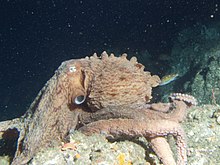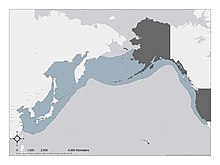| Giant Pacific octopus Temporal range: Pleistocene to recent[1]
| |
|---|---|

| |
| E. dofleini observed off Point Piños, California, at a depth of 65 m (213 ft) | |
| Scientific classification | |
| Domain: | Eukaryota |
| Kingdom: | Animalia |
| Phylum: | Mollusca |
| Class: | Cephalopoda |
| Order: | Octopoda |
| Family: | Enteroctopodidae |
| Genus: | Enteroctopus |
| Species: | E. dofleini
|
| Binomial name | |
| Enteroctopus dofleini (Wülker, 1910)
| |

| |
| range of E. dofleini | |
| Synonyms | |
| |
The giant Pacific octopus (Enteroctopus dofleini), also known as the North Pacific giant octopus, is a large marine cephalopod belonging to the genus Enteroctopus and Enteroctopodidae family. Its spatial distribution encompasses much of the coastal North Pacific, from the Mexican state of Baja California, north along the United States' West Coast (California, Oregon, Washington and Alaska, including the Aleutian Islands), and British Columbia, Canada; across the northern Pacific to the Russian Far East (Kamchatka, Sea of Okhotsk), south to the East China Sea, the Yellow Sea, the Sea of Japan, Japan's Pacific east coast, and around the Korean Peninsula.[3] It can be found from the intertidal zone down to 2,000 m (6,600 ft), and is best-adapted to colder, oxygen- and nutrient-rich waters. It is the largest octopus species on earth and can often be found in aquariums and research facilities in addition to the ocean.[4][5][6] E. dofleini play an important role in maintaining the health and biodiversity of deep sea ecosystems, cognitive research, and the fishing industry.
- ^ "Distribution of Recent Cephalopoda and implications for Plio-Pleistocene events". Retrieved 4 April 2022.
- ^ Allcock, L.; Taite, M.; Allen, G. (2018). "Enteroctopus dofleini". IUCN Red List of Threatened Species. 2018: e.T162958A958049. doi:10.2305/IUCN.UK.2018-2.RLTS.T162958A958049.en. Retrieved 30 October 2022.
- ^ Cosgrove, James (2009). Super Suckers, The Giant Pacific octopus. BC: Harbour Publishing. ISBN 978-1-55017-466-3.
- ^ "Giant Pacific Octopus Species Profile". Alaska Department of Fish and Game.
- ^ Graves, Mark (23 June 2023). "Giant Pacific octopus rescued at Haystack Rock". The Oregonian. Archived from the original on 24 June 2023.
- ^ Kirby, Ashley J.; Balko, Julie A.; Goertz, Caroline E. C.; Lewbart, Gregory A. (July 2023). "Characterization of Current Husbandry and Veterinary Care Practices of the Giant Pacific Octopus (Enteroctopus dofleini) Using an Online Survey". Veterinary Sciences. 10 (7): 448. doi:10.3390/vetsci10070448. ISSN 2306-7381. PMC 10385140. PMID 37505853.
